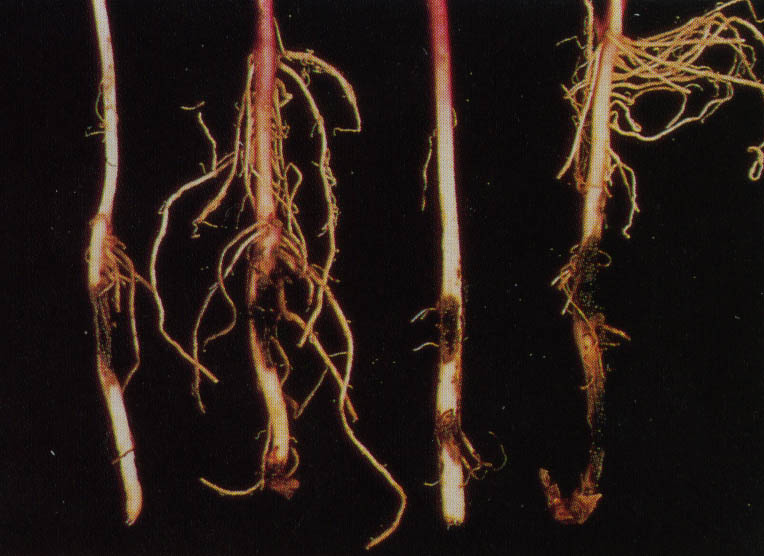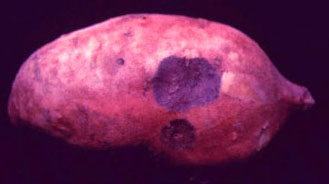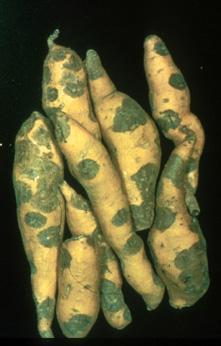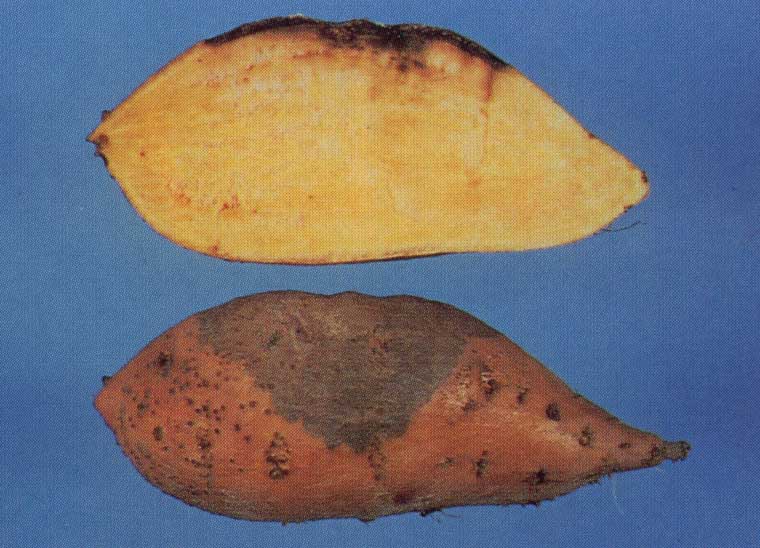|
|
Kingdom |
Fungi |
|
Phylum |
Ascomycota |
|
Order |
Ophiostomatales |
|
Family |
Ophiostomataceae |
Black rot is
economically important. It results in heavy losses in seedbeds, in
the field and more importantly, in storage. The transplants eventually die
in seedbeds; reduces yield in the field and renders roots in storage
unmarketable because of the unsightly black lesions, rotting and bitter
taste.
Africa (Congo
Democratic Republic, Cote dĺIvoire, Ghana, Seychelles, South Africa, Uganda);
Americas- Central (Costa Rica, El Salvador, Guatemala, Nicaragua,
Panama, Suriname, North (Mexico, USA; South (Brazil, Colombia,
Ecuador, Guyana, Peru, Venezuela); Asia (Brunei, Cambodia, China,
Indonesia, Japan, Korea, Malaysia, Myanmar, Philippines, Thailand); Australia;
Caribbean (Cuba, Grenada, Dominican Republic, Haiti, Jamaica, Puerto Rico, Saint
Lucia, Trinidad and Tobago); Europe (France, Italy, Poland, United
Kingdom); and Pacific Islands (American Samoa, Fiji, Papua New Guinea,
Samoa, Solomon Island).
The disease is called black rot because of its symptoms on storage
roots. However, the disease can be serious on young sprouts and adult plants.
Infected sprouts develop black sunken necrotic lesions or cankers on the stem
under the soil.
In the field plants are stunted and chlorotic due to the cankers present in
the underground stem. Chlorotic leaves drop.
On storage roots the first symptoms are brown, slightly sunken spots not more
than 0.5 cm in diameter. These spots continue to enlarge in storage, transit and
marketing, enlarging up to 5 cm in size. The lesions become firm, dry and black
and can coalesce to cover the entire root. A particular feature of this
disease is the presence of fungal structures (long necked perithecia) protruding
from the affected tissue. The lesions are generally shallow, however in some
cases a deeper rotting develops due to the presence of secondary organisms,
generally bacteria.
The tissues in the rotten spots and their surroundings have a bitter
taste but fruity odour.
The perithecia are superficial or
partly to completely immersed, brown to black, globose, 140-220 Ám in diameter,
unornamented, with long black neck, pale brown to subhyaline toward the
tip, tapering slightly, up to 900 mm long and with erect or moderately
divergent, hyaline ostiolar hyphae. The ascospores
are elliptical with a gelatinous sheath forming a brim, giving a hat-shaped
appearance, hyaline, non-septate, smooth and measure 4.5-8 x 2.5-5.5 Ám.
The conidiophores are slender,
arising laterally from the hyphae, septate, phialidic, hyaline to very pale
brown, up to 160 Ám, usually tapering towards the tip and producing a
succession of conidia through the open end. The conidia
are cylindrical, truncate at the ends, hyaline, smooth walled, 11-25 (15) x
4-5.5 Ám. The chlamydospores are
terminal in chains, obovate to oval, thick walled, brown, of 9-18 x 6-13 Ám. A
thick walled endoconidial form is present.
The fungus is parasitic on a wide range of hosts, but there is physiological
specialization, and presence of different strains. The sweetpotato strain is an
important wound parasite that affects mainly fleshy roots in storage, transit,
and marketing, although it also causes damage to plants in seedbeds and in the
field. Any sort of wounding increases the possibility of infection, but the
fungus can also penetrate through lenticels.
Sweetpotato roots can carry the infection from the field, and when infected
roots are used for propagation, infected shoots are produced. In storage, roots
develop black rot when temperatures are favourable. It has been found that
disease development is most rapid at 25oC, but is reduced at higher
temperatures.
The fungus is also soil-transmitted by chlamydospores that survive in dry
soil and plant debris after harvest. Once in storage, insects such as
sweetpotato w
eevil and rodents can spread the infection.
The bitter taste comes from the phytoalexin,
ipomeamarone, produced by the storage roots in response to C. fimbriata
infection while the fruity odour is from the volatile compound, amyl acetate
produced after infection.
The sweetpotato strain of C. fimbriata only infects sweetpotato
but many plants, especially trees, are hosts to other strains.
Cultural control
Use of healthy material for transplanting.
Curing storage roots immediately after harvest.
Fumigation of crates/containers and storeroom.
Control of insects and rodents.
Crop rotation for five years.
Host-plant resistance
Use of less susceptible cultivars.
Chemical control
Recommended fungicides for fleshy root treatment are Benomyl and Thibendazole
used for dipping planting materials and spraying the roots before storage.
Cheo, P.C. 1953. Varietal differences in susceptibility of sweet potato to
black rot fungus. Phytopathology 43:78-81.
Clark, C.A. and J. Moyer. 1988. Compendium of Sweet Potato Diseases. APS
Press. 74 p.
Holliday, P. 1980. Fungus Diseases of Tropical Crops. Dover Publications,
Inc. New York 607 p.
Morgan-Jones,
G. 1967. Ceratocystis fimbriata. C.M.I. Descriptions of Pathogenic Fungi
and Bacteria. No. 141.
Contributed
by: Teresa Ames |
Taxonomy
Economic
importance
Geographical
distribution
Symptoms
Morphology
Biology
and ecology
Host
range
Management
References

Dark, sunken lesions on the base of sprouts grown from infected storage
roots (W. Martin, APS).

Black
sunken lesion on storage root of a purple-skinned cultivar (W. Martin,
APS).

Storage
roots of a brownish orange-skinned cultivar with black rot lesions (W.
Martin, APS).

The internal and external appearance of a black rot lesion (C. Clark, APS). |

